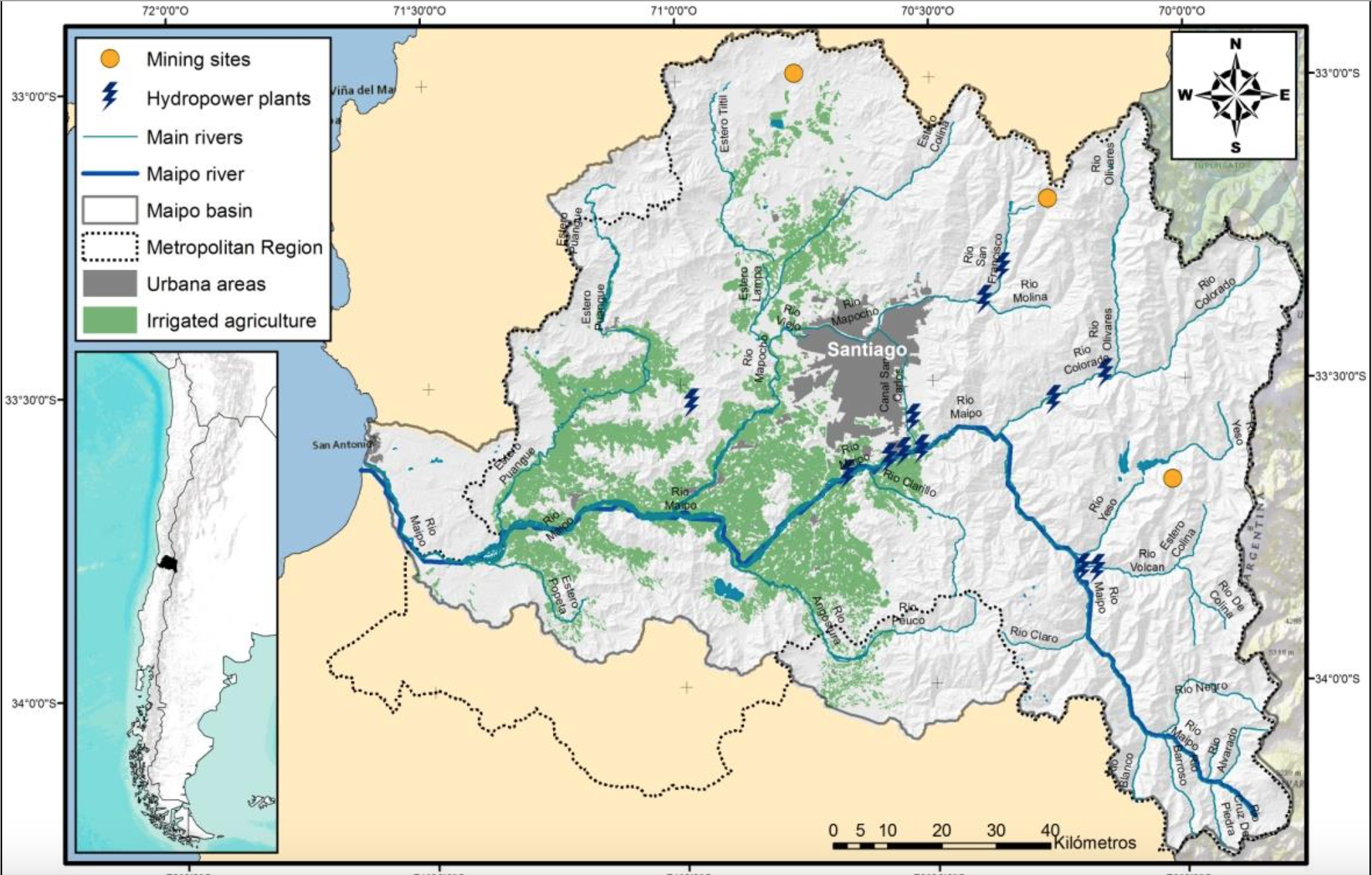 Source: ICLEI, 2014
Source: ICLEI, 2014Santiago, the capital of Chile, has a metropolitan area population of 6 million and an average population density of 8,464 per square kilometer (CIA, 2009). Responsible for 40% of the country’s total GDP, the city is governed by three municipal governmental branches—two of which are federally appointed while one is democratically elected. National interests tend to dominate the local urban agenda due to an influential state executive branch (Barton, 2013).
Located within a valley, the city faces a unique set of climate change challenges including pollution, temperature increases, and water scarcity. Utilizing the climate risk assessment (Mehrotra et al., 2009), the main risk facing Santiago is water scarcity due to a projected 40% reduction in water availability by 2070 combined with a growing population, expected to reach 8 million by 2030—an increase of 30% (McPhee, et al., 2014). The Water Exploitation Index deems the Santiago Basin under high water stress in normal years and very high stress in dry years (Krellenberg et al., 2014). Compounding the issue of reduced water supply is the number of industries competing for the limited water resource (Barton et al., 2014). The water and sanitation system in Santiago was privatized under the Water Code of 1981, creating a for profit monopoly (Zuluaga, M. A., et al 2000). The lower income populations are left most vulnerable to the effects of drought.
There is a high level of socio-spacial segregation in Santiago with water use distinctly correlated with income (Meza, et al., 2014). Private utility companies retain the right to decide which areas to service. Basing decisions on a balance of connection costs against water sale revenues, low-income peri-urban settlements are often not serviced. Non-utility zones rely on self-managed groundwater supplies extremely vulnerable to drought, with the groundwater table in Santiago having fallen from 14 to 26 meters below the surface from 1971 to 2001 (Lehn, et al., 2012). Based on the current distribution and use of water rights, we propose an adaptive climate change response strategy focused on improved water efficiency and access to the poor.
With agriculture responsible for 74% of water demand in the watershed, Santiago must shift the focus of agricultural subsides to water efficiency (Lehn et al., 2012). This would encompass incentives for infrastructure improvements such as water-saving drip irrigation and the development of greywater reuse systems. A regional land use plan to avoid the extension of irrigated agricultural land would be enforced through the newly established centralized water authority that would include several significant stakeholders (Simon et al., 2011). Using an integrated watershed management method (Bouwer, 2008), this authority would facilitate water rights trading—establishing government water rights to restore ecological flows and provide water access to the poor.
A second adaptive policy mechanism would be the establishment of a citywide sustainable urban development authority entitled the Ministry of Sustainable Urban Development (Krellenberg et al., 2014). Driven by long-term adaptive response planning, this authority would develop the city’s first official climate adaptation plan, carrying out measures such as connecting the vulnerable low-income communities to the utility network, providing a set of connection-based subsidies to the poor, and placing a tax on excessive household consumption to encourage conservation and create a funding source to carry out equitable water distribution.
This article is a product of Professor Shagun Mehrotra’s Climate Change and Cities class. Analysis is based on the Framework for City Climate Risk Assessment and Climate Change and Cities:First Assessment Report of the Urban Climate Change Research Network. Views expressed are entirely those of the authors.
References
Barton, J. & Vicuna, S. (2014). From climate threats to climate action in the city of Santiago de Chile and the Maipo Basin: The science perspective. ICLEI. Retrieved from http://resilient-cities.iclei.org
Barton, J. (2013). Climate Change Adaptive Capacity in Santiago de Chile: Creating a Governance Regime for Sustainability Planning. International Journal of Urban and Regional Research 37.6. 1916 –1933.
Bouwer, H. (2008). Integrates water management: emerging issues and challenges. Agricultural Water Management 45. 217–228.
Krellenberg, K. & Handjurgens, B. (2014). Climate Adaptation Santiago. Springer Science and Business Media, 4, 140 –158. Doi:10.1007/978-3-642-39103-3_5
Krellenberg, K. Jordan, R. Rehner, J. Shwarz, A. Infante, B. Barth, K. Perez, A. (2014) Adaptation to Climate Change in Megacities of Latin America. United Nations-Eclac. Retrieved from http://repositorio.cepal.org/bitstream/handle/11362/35898/S2013069_en.pdf?sequence=1
Lehn, H., McPhee, J., Vogdt, J., Schleenstein, G., Simon. L, Strauch, G., Barbieri, C., & Nini, Y. (2012). Risks and Opportunities for Sustainable Management of Water Resources and Services in Santiago de Chile. Risk Habitat Megacity, 251–287.
Mehrotra, S., C.E. Natenzon, A. Omojola, R. Folorunsho, J. Gilbride & C. Rosenzweig. (2009). Framework for city climate risk assessment. Washington, DC: World Bank.
McPhee, J., Cortes, G., Rojas, M., Garcia, M., Descalzi, A., & Vargas, L. (2014). Downscaling Climate Changes for Santiago: What Effects can be Expacted? Springer Science and Business Media, 2, 19 – 41.
Meza, F. J., Vicuña, S., Jelinek, M., Bustos, E., Bonelli, S. (2014). Assessing water demands and coverage sensitivity to climate change in the urban and rural sectors in Central Chile. Journal of Water and Climate Change.
Simon, L., Lehn, H. (2012). Climate Adaptation Strategies for a Sustainable Water Management in the Metropolitan Region of Santiago de Chile. Climate Adaptation Santiago. Retrieved from http://resilient-cities.iclei.org/fileadmin/sites/resilient-cities/files/Resilient_Cities_2011/Presentations/F/F2_Simon.pd
The World Factbook. (2009). Central Intelligence Agency. https://www.cia.gov/library/publications
Zuluaga, Maria Ana, Mary Shirley, and Lixin Xu. (2004). “Reforming the Urban Water System in Santiago, Chile.” Policy Research Working Papers. Social Science Research Network.